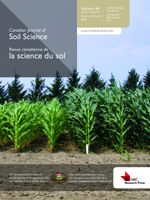Zhang, B., Yang, X., Drury, C. F., Reynolds, W. D., He, H. and Zhang, X. 2012. Effects of 49 years of fertilization on the distribution and accumulation of soil carbon under corn cultivation. Can. J. Soil Sci. 92: 835-839. The effects of 49 yr of monoculture corn (Zea mays L.) production with/without chemical fertilizer addition on the origin and distribution of soil organic carbon (C) among the sand (53-2000 µm), silt (2-53 µm), and clay (<2 µm) particle size fractions in the top 20 cm of a clay loam soil were evaluated using the carbon-13 isotope abundance technique. The C derived from corn (newly formed C4-plant C) was greater under chemical fertilization relative to no fertilization in all three size fractions. However, the resident (old) C derived from C3-plants grown prior to corn was similar between the fertilized and unfertilized treatments for each size fraction. Fertilization of monoculture corn had little impact on the amount of native-formed C3-plant C, particularly in the silt and clay fractions, but did increase the amount of newly formed C4-plant C.
How to translate text using browser tools
1 November 2012
Effects of 49 years of fertilization on the distribution and accumulation of soil carbon under corn cultivation
Bin Zhang,
Xueming Yang,
Craig F. Drury,
W. Daniel Reynolds,
Hongbo He,
Xudong Zhang
ACCESS THE FULL ARTICLE
It is not available for individual sale.
This article is only available to subscribers.
It is not available for individual sale.
It is not available for individual sale.
carbone organique du sol
d13C
d13C
fertilisation
fertilization
fractions granulométriques
particle size fraction





